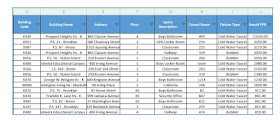 |
| NeQuan McLean at April 15 protest vs charter mailings; credit: NY Daily News |
After vehement parent protests and a FERPA privacy complaint submitted to the US Department of Education, the DOE announced they will allow parents to opt out of charter mailings in the future, as the Daily News reported today. This is NOT good enough, either from a policy or privacy standpoint.
Best practice to ensure student privacy would require parental consent, as the US Department of Education notes - especially as many parents will not notice the opt out forms in backpack mail or their children may forget to share it with them.
Best practice from the standpoint of good policy would be for the DOE not to allow charter schools to buy access to this information at all – which only helps them market their schools and expand their enrollment.
NYC is the ONLY district in the entire country that voluntarily helps charter schools expand in this manner; even ostensibly pro-charter districts like Chicago don’t make this information available to charter schools.
At the recent NEA forum for presidential candidates, Mayor de Blasio aggressively postured about how he opposed charter schools:
“I’m going to be blunt with you, I am angry about the state of public education in America…“I am angry about the privatizers. I am sick and tired of these efforts to privatize a precious thing we need — public education. I know we’re not supposed to be saying ‘hate’ — our teachers taught us not to — I hate the privatizers and I want to stop them,” he said.At the recent NEA forum for presidential candidates, Mayor de Blasio aggressively postured about how he opposed charter schools:
Charter schools already drain more than $2.1 billion from the DOE budget as well as take up valuable space in our overcrowded public school buildings. Too bad that the Mayor continues to favor the privatizers in his actions, if not his words.
The email about this from Hydra Mendoza, DOE Deputy Chancellor is below.
---------- Forwarded message ---------
From: Mendoza Hydra <HMendoza3@schools.nyc.gov>
Date: Tue, Aug 27, 2019, 3:22 PM
Subject: Charter mailings
Date: Tue, Aug 27, 2019, 3:22 PM
Subject: Charter mailings
Hi All,
Per my “heads up” text regarding the changes to charter mailings through Vanguard, below please find more specific information.
- Today we are announcing that parents will be able to remove their address from the parent contact list DOE shares with Vanguard.
- Over the past several months, we've heard concerns from families about unsolicited outreach from charter schools as well as concerns from families who want access to this information.
- We believe creating an avenue for families to remove their addresses meets the needs of all.
- Families will receive a letter and removal form in their back to school packet on September 9th informing them of their ability to remove their addresses. Families will be able to return the removal form within 30 days.
- Additionally, families will be informed that they can go on the DOE website at any time to remove their addresses from the list. We will have a direct link.
- Vanguard services for charter schools will be temporarily suspended until October 25 while refusal forms are collected and files are updated accordingly. Charter schools will still be able to buy mailing lists as other organizations and companies do.
- The DOE will refresh the refusal list 4x per year – October, December, February and April.
- This information will be provided to all principals through the PWeekly.
Please let me know if you have any further questions! Hope everyone is well and ready for the first day of school!
Thank you,
Hydra
Hydra Mendoza
Deputy Chancellor
Division of Community Empowerment, Partnerships and Communication
New York City Department of Education
52 Chambers Street| Suite 320 |NY, NY 10007
HMendoza3@schools.nyc.gov | (212) 374-2486
Connect with us on schools.nyc.gov

